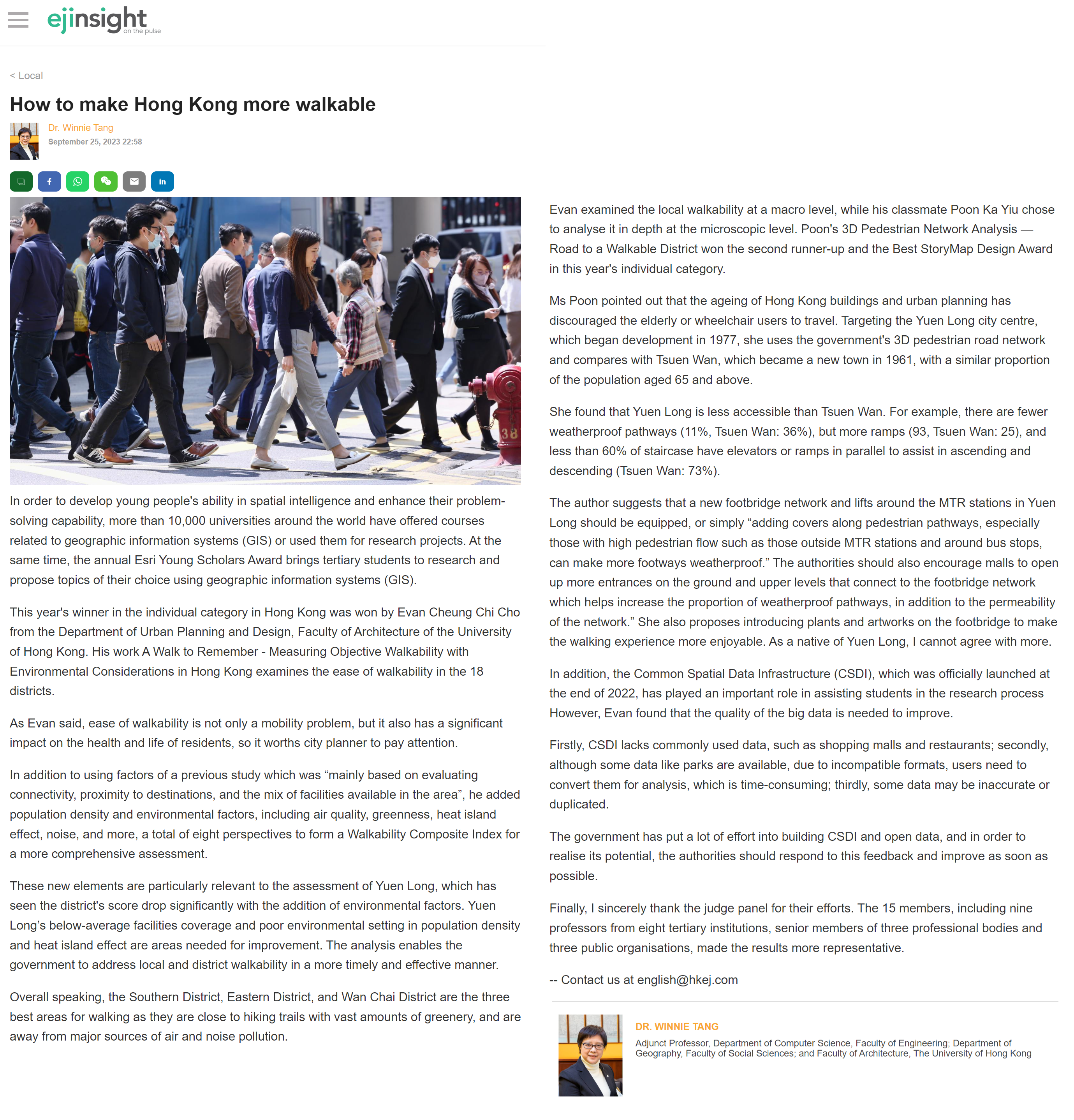網上版請按此

How to make Hong Kong more walkable
In order to develop young people's ability in spatial intelligence and enhance their problem-solving capability, more than 10,000 universities around the world have offered courses related to geographic information systems (GIS) or used them for research projects. At the same time, the annual Esri Young Scholars Award brings tertiary students to research and propose topics of their choice using geographic information systems (GIS).
This year's winner in the individual category in Hong Kong was won by Evan Cheung Chi Cho from the Department of Urban Planning and Design, Faculty of Architecture of the University of Hong Kong. His work A Walk to Remember - Measuring Objective Walkability with Environmental Considerations in Hong Kong examines the ease of walkability in the 18 districts.
As Evan said, ease of walkability is not only a mobility problem, but it also has a significant impact on the health and life of residents, so it worths city planner to pay attention.
In addition to using factors of a previous study which was “mainly based on evaluating connectivity, proximity to destinations, and the mix of facilities available in the area”, he added population density and environmental factors, including air quality, greenness, heat island effect, noise, and more, a total of eight perspectives to form a Walkability Composite Index for a more comprehensive assessment.
These new elements are particularly relevant to the assessment of Yuen Long, which has seen the district's score drop significantly with the addition of environmental factors. Yuen Long’s below-average facilities coverage and poor environmental setting in population density and heat island effect are areas needed for improvement. The analysis enables the government to address local and district walkability in a more timely and effective manner.
Overall speaking, the Southern District, Eastern District, and Wan Chai District are the three best areas for walking as they are close to hiking trails with vast amounts of greenery, and are away from major sources of air and noise pollution.
Evan examined the local walkability at a macro level, while his classmate Poon Ka Yiu chose to analyse it in depth at the microscopic level. Poon's 3D Pedestrian Network Analysis — Road to a Walkable District won the second runner-up and the Best StoryMap Design Award in this year's individual category.
Ms Poon pointed out that the ageing of Hong Kong buildings and urban planning has discouraged the elderly or wheelchair users to travel. Targeting the Yuen Long city centre, which began development in 1977, she uses the government's 3D pedestrian road network and compares with Tsuen Wan, which became a new town in 1961, with a similar proportion of the population aged 65 and above.
She found that Yuen Long is less accessible than Tsuen Wan. For example, there are fewer weatherproof pathways (11%, Tsuen Wan: 36%), but more ramps (93, Tsuen Wan: 25), and less than 60% of staircase have elevators or ramps in parallel to assist in ascending and descending (Tsuen Wan: 73%).
The author suggests that a new footbridge network and lifts around the MTR stations in Yuen Long should be equipped, or simply “adding covers along pedestrian pathways, especially those with high pedestrian flow such as those outside MTR stations and around bus stops, can make more footways weatherproof.” The authorities should also encourage malls to open up more entrances on the ground and upper levels that connect to the footbridge network which helps increase the proportion of weatherproof pathways, in addition to the permeability of the network.” She also proposes introducing plants and artworks on the footbridge to make the walking experience more enjoyable. As a native of Yuen Long, I cannot agree with more.
In addition, the Common Spatial Data Infrastructure (CSDI), which was officially launched at the end of 2022, has played an important role in assisting students in the research process However, Evan found that the quality of the big data is needed to improve.
Firstly, CSDI lacks commonly used data, such as shopping malls and restaurants; secondly, although some data like parks are available, due to incompatible formats, users need to convert them for analysis, which is time-consuming; thirdly, some data may be inaccurate or duplicated.
The government has put a lot of effort into building CSDI and open data, and in order to realise its potential, the authorities should respond to this feedback and improve as soon as possible.
Finally, I sincerely thank the judge panel for their efforts. The 15 members, including nine professors from eight tertiary institutions, senior members of three professional bodies and three public organisations, made the results more representative.
Dr. Winnie Tang
Adjunct Professor, Department of Computer Science, Faculty of Engineering; Department of Geography, Faculty of Social Sciences; and Faculty of Architecture, The University of Hong Kong